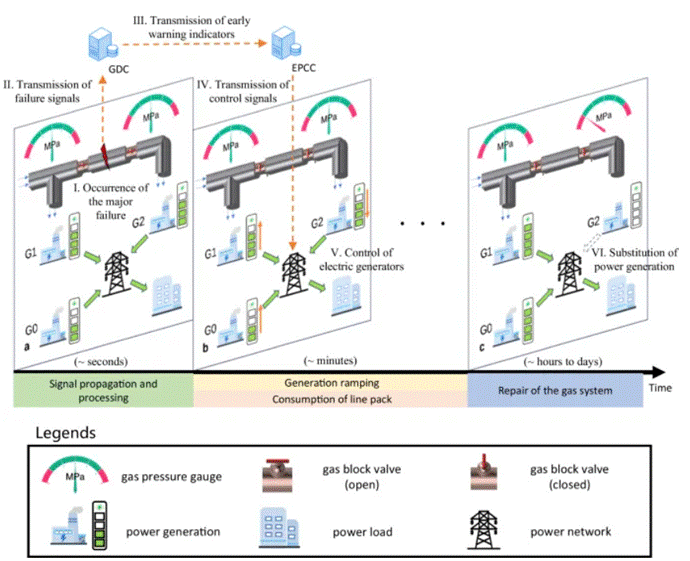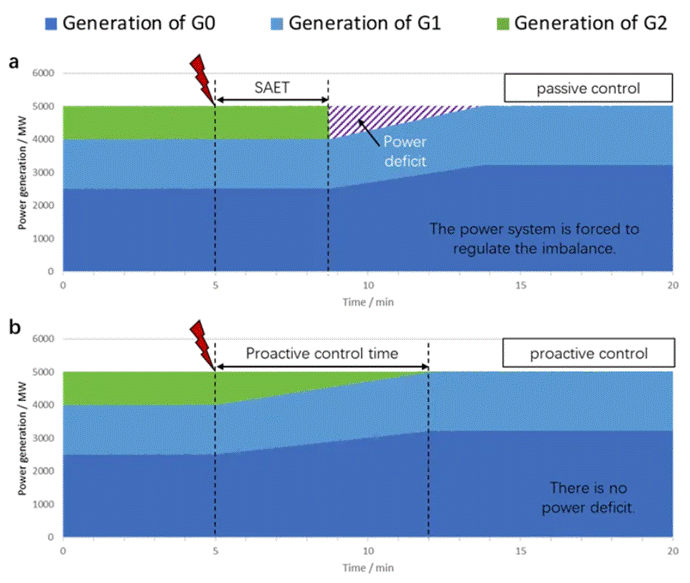With the global transition to low-carbon energy, gas power generation is gradually replacing traditional coal-fired power due to its lower carbon emissions and greater flexibility, becoming an essential part of the power system. However, the increasing interdependence between gas transmission networks and power networks presents new challenges, especially as gas network failures could lead to large-scale power outages. For example, in February 2021, extreme cold weather in the southern United States caused gas transmission network failures, leading to fuel supply loss for many gas units and widespread blackouts. Similar incidents have occurred in other countries and regions. These events indicate that in systems where gas and electricity networks are highly coupled, a failure in the gas network can extend its impact beyond the gas system itself, potentially triggering severe cascading effects in the power system. Therefore, effectively addressing natural gas network failures to mitigate their negative impacts on the power grid has become a critical issue in the field of energy internet. In this context, the scheduling automation research group of the Department of Electrical Engineering and Applied Electronics (EEA), Tsinghua University has proposed an innovative early warning system for gas-electric coupled failures, providing new insights into this issue. The related findings were published in the internationally renowned journal Nature Communications in the paper titled “Early Warning and Proactive Control Strategies for Power Blackouts Caused by Gas Network Malfunctions.” The first author is PhD student Yu Fengshuo of EEA, with the corresponding author being Professor Sun Hongbin, Vice President of Taiyuan University of Technology and from EEA. The author team also includes Professor Guo Qinglai from Tsinghua University, Professor Wu Jianzhong from Cardiff University, and PhD student Qiao Zheng from Tsinghua University. This paper is supported by funding from the National Key Research and Development Program (2022YFB2404000) and the EPSRC/NFSC project (EP/T021969/1).

Figure 1: Principle of the Early Warning System for Gas-Electric Coupled Failures
The early warning system designed by the research team for gas-electric coupled failures draws on the principle of earthquake early warning, utilizing the physical characteristic that the actual fault propagation speed in the gas network is much lower than the speed of the warning signal. By promptly transmitting information about gas network failures and actively controlling the power system, the system effectively reduces the negative impacts of gas network failures on the power system. The core of this system lies in leveraging the delay in fault propagation, allowing the power system to make proactive adjustments before the effects of the fault arrive.

Figure 2: Calculation of Warning Signals
Specifically, the early warning system for gas-electric coupled failures includes perception and decision modules. Through these modules, the power system can gain more response time to faults, minimizing losses caused by load shedding. When a fault occurs in the gas network, the fault signal is sent to the Gas Dispatch Center (GDC). After analyzing the fault information, the GDC quickly transmits the generated warning signal to the Electric Power Control Center (EPCC). Upon receiving the fault signal, the EPCC initiates proactive control measures for the power system, while the impact of the gas network fault has not yet spread to the power system.

Figure 3: Principles of Proactive Control in the Power System
The research team introduced two key warning indicators: Available Escape Time (AET) and Available Gas Pipeline Storage (ALP). AET represents the remaining reaction time of the power system after a gas network fault occurs, while ALP indicates the amount of gas still available in the pipeline for the affected gas turbines to operate normally after a gas system fault. Based on these two indicators, the EPCC can formulate appropriate proactive control strategies for the power system without needing additional gas network information. The research team chose a real gas-electric coupling network in China for case validation, simulating major fault scenarios such as gas source failures and pipeline ruptures. In each scenario, the GDC immediately transmits information to the EPCC after the fault occurs. The EPCC quickly assesses the impact of the fault on the power system based on AET and ALP and takes proactive control measures such as activating backup capacity and adjusting power load. The results show that in these scenarios, the early warning system significantly reduced the power gap in the power system, effectively preventing major blackout incidents. The proposed early warning system for gas-electric coupled failures offers a new perspective for researching cascading failures in multi-energy coupling systems and marks a significant advancement in core technologies for energy internet. Although this research still requires further validation in broader applications, initial results indicate its immense potential for enhancing the safety of gas-electric coupling systems. Professor Sun Hongbin’s research team not only contributes to improving the safety of integrated energy systems but also provides new technical support for achieving carbon neutrality.
Original Link (click “Read Original” at the end):
https://www.nature.com/articles/s41467-024-48964-0

















 News & Events
News & Events